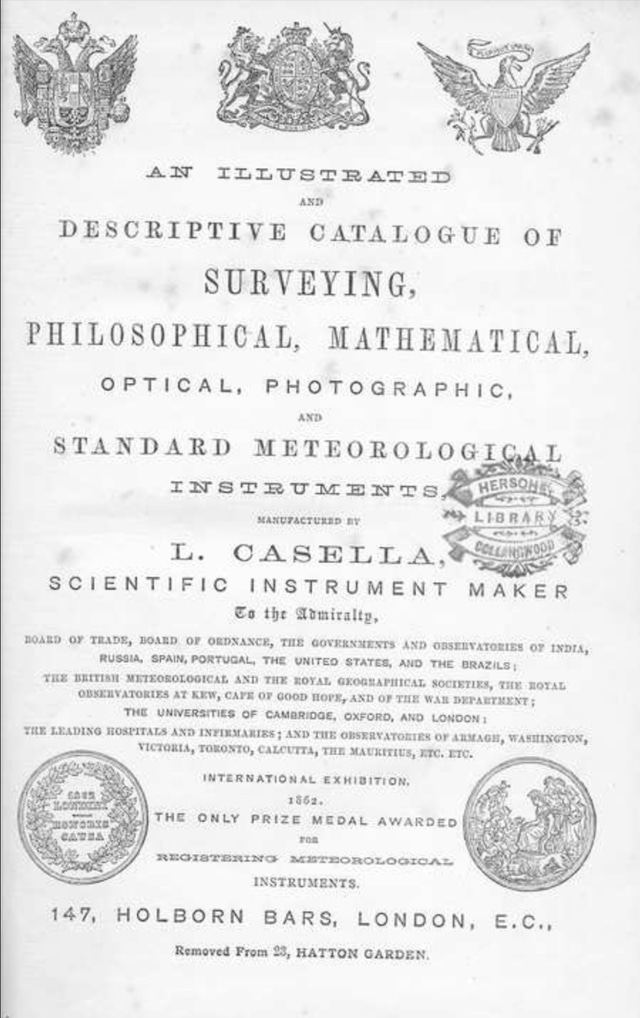

Casella: The Story of a Distinguished Manufacturer of Meteorological Instruments in Britain
The Casella family left a profound mark on the history of British instrument making, particularly in the field of meteorological devices. Originally from the town of Tavernerio near Lake Como in Northern Italy, the Casellas were part of a broader wave of Italian artisan migration to Britain that began in the late 18th and early 19th centuries. Skilled in woodcarving, optics, and glassblowing, these craftsmen brought with them the traditions of Italian workmanship and influenced the development of English scientific instrument manufacturing.
The Early Years: Louis Casella
Louis Casella was born in Edinburgh in 1812. His father, a musician, painter, and writer, came from a large Italian family and moved to the United Kingdom in pursuit of a better life for his children. Louis was one of the youngest of seventeen children. Gifted in mathematics and science, he soon became part of the new culture of scientific instrument making in London.
Louis became an apprentice to Cesare Tagliabue, a renowned maker of optical instruments. In 1837, he married Tagliabue’s daughter Marie Louise, and in the following year, became a partner in the family business, which was renamed Tagliabue & Casella.
In 1799, the Italian scientific instrument maker Caesar Tagliabue founded a workshop in the Holborn area of West London. It was one of the first workshops in England specializing in the production of high-precision measuring instruments, including barometers, thermometers, anemometers, and other meteorological devices. In 1820, the workshop moved to 23 Hatton Garden—the future heart of a “barometer cluster” where Italian craftsmen would live and work for decades.
After Tagliabue’s death in 1844, the company was renamed Louis Casella & Co. (often listed as L.P. Casella), under which it gained international recognition. During this period, Casella began collaborating with leading British scientists and explorers, including Charles Darwin, David Livingstone, Francis Galton, and supplied equipment for expeditions led by Lord Shomberg Kerr, Richard Burton, John Hanning Speke, and Halleur.
Meteorology and Scientific Achievements
By around 1850, Casella had become one of the largest meteorological instrument manufacturers in Britain—and likely in all of Europe. Among its innovations was the first clinical thermometer, and the company’s catalogs of scientific instruments were widely circulated internationally.
The Casella product range included:
The firm also produced numerous barometers for agriculture, mining, and marine use, including patented models designed for specific field conditions.
A Family Legacy
By 1875, L. Casella was offering more than 75 types of clocks and around 100 varieties of thermometers. The firm competed with Negretti & Zambra in the barograph market from the 1860s onward. Production continued uninterrupted for over 120 years, serving schools, scientific societies, and the military. Louis’s sons—Louis Marino and Charles Frederick Casella—both joined the company.
After Louis’s death in 1897, the business passed to Charles Frederick Casella, who upheld the family legacy. In 1905, the company moved from Holborn to Westminster, and again in 1912 to South London. In 1910, the firm was officially incorporated as C.F. Casella & Co.
After Charles’s death in 1916, the firm partially merged with D. Gilson & Co. in 1918, a manufacturer of screws and precision turned parts. Nevertheless, the Casella brand remained intact.
Global Expansion and Modernization
Throughout the 20th century, Casella became a leading British manufacturer of scientific and meteorological equipment, gaining international acclaim. Its barometers, thermographs, anemometers, vibrometers, and environmental monitoring systems were used in laboratories, field research, geology, climate studies, and industrial safety applications.
By the mid-20th century, Casella’s name was recognized around the world. During World War II, the company contributed to the production of military instrumentation for the British Ministry of Munitions.
In the 1980s, Casella expanded into the United States, establishing a presence and beginning local distribution of its products. This strategic move enabled the company to supply environmental and industrial monitoring equipment throughout North America.
In 2006, Casella was acquired by Ideal Industries Inc., a major American manufacturer of electrical and measurement equipment. Under Ideal’s ownership, the Casella brand was strengthened in international markets, particularly in the U.S., where Casella USA now offers sound level meters, dosimeters, dust monitors, and environmental monitoring systems widely used in industry, science, and construction.
Today
Today, Casella continues to operate under the name Casella Solutions, with offices in Aylesbury, UK, and Amherst, New Hampshire, USA. The company remains focused on environmental, vibration, dust, and noise monitoring systems—continuing the legacy forged by master instrument makers from the shores of Lake Como over two centuries ago.